"Fix It Fast, Cook It Slow"October 7, 2010 - Volume 1, Issue 15
|
|
|
|
|
|
Supper's Ready!
| It's a dream come true, walk in the door after a long day at work and
supper is ready! As you step across the threshold, the waiting aromas
let you know it's going to taste good. For the cooler season ahead,
we've moved our slow cooker to the front of the countertop in our
kitchen. Delicious food with little effort awaits!
IN THIS ISSUE,
we explore one of our favorite cooking techniques, slow cooking. Just
how does it work? Where does slow cooking excel, (and where does it not
perform)? We cover what's important in choosing a slow cooker, 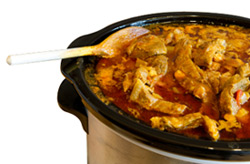 and
how to care for your BFF (best friends forever) appliance. You'll find
plenty of tips for advancing your slow cooking skills and three
appetizing recipes that showcase slow cooking at its best. and
how to care for your BFF (best friends forever) appliance. You'll find
plenty of tips for advancing your slow cooking skills and three
appetizing recipes that showcase slow cooking at its best.
|
Ken's Notes:
|  We just received the menu for our upcoming: We just received the menu for our upcoming:
Chantal Cookware Demonstration
on Oct. 24th
Chef Deb Jech will be preparing Chicken Saltimbocca with Artichoke Sauce, Pan-Seared Asparagus, Roasted Vegetable and Fresh Ricotta Sandwiches, and a Warm Chocolate Cheesecake - All in Chantal Copper Fusion cookware! Like all of our classes, there'll be plenty of food to sample, lots of questions, talking and learning, recipes to take home and in this class, a bonus! Each participant will also leave with their very own 8" Chantal Copper Fusion Fry Pan, a $60 value! More info can be found below.
Kyocera, the Japanese manufacturer of ceramic knives, is starting to feel some competition in a marketplace that was once exclusively theirs. Their response? Lower prices! We've dropped anywhere from $5 to $25 on individual knives and sets. While the lower price is a great benefit, what I've learned is that most of the new ceramic knives are not as good a quality as Kyocera's. Market research showed that consumers think all ceramic knives are the same, yet, just like steel knives, there are huge variations in hardness and edge-keeping abilities. In the near future you'll start to see 6" ceramic chef's knives for under $20 in the big box stores. All I can say is - educate yourself before you buy.
|
|
|
|
Cooking Classes at The Cook's Shop!
| 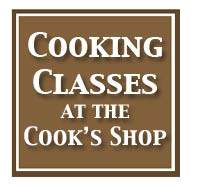
The Perfect Holiday Dinner, Standing Rib a la Harrod's of London - Monday, Oct 11, 2010 - 6:30 pm, $45. Babette Bole - Caterer, Wine Expert, Marietta, OH. Learn
the proper staging for this elegant meal (so the host has as much fun
as the guests!), how to cook complementary side dishes and choose the
perfect wine. Class is limited to 15.
Cooking With Emad, Lamb Dinner - Monday, Oct 18, 2010 - 6:30 pm, $55
Emad Al-Masri - Chef/Owner, The Buckley House, Marietta, OH. Emad
is baaack, with laaaamb! This is guaranteed to be an entertaining
evening with thoughtful discussion of Emad's wonderful cooking
techniques. A full course lamb meal will be demonstrated. We challenge
you to pick up on all of Emad's secrets. Register early - this class
sold out in two days the last time it was offered! Class is limited to
15.
Cooking With Chantal Copper Fusion Cookware - Sunday, Oct 24, 2010 - 1:00 pm, $50
Deb Jech - Factory Representative, Chef for Chantal Cookware. The
Chantal Copper Fusion line is a solid copper cookware with a porcelain
inner and outer coating. The heat is beautifully diffused all the way up
the sides while cooking, using lower, more controlled heat. Learn the
basics about this cookware from an expert chef and go home with your
very own 8" Chantal Copper Fusion Fry Pan, a $60 value! Class is limited
to 15.
Fun With Phyllo - Holiday Appetizers - Monday, Oct 25, 2010 - 6:30 pm, $30
Gayle Shank - In-house Chef. Fear
of Phyllo? Not any more! Gail will cover all of the ins and outs of
preparing phyllo appitizers for the holidays. Strudel, Baked Brie, and
Spanakopita will all be covered in detail. Class is limited to 15.
Hearty Winter Soups - Monday, Nov 1, 2010 - 6:30 pm, $30
Gayle Shank - In-house Chef. With
cold weather comes comfort foods... and wonderful soups. Learn how to
make Six Onion Soup, Hungarian Mushroom Soup, Butternut Squash Soup and
possibly one more. Class is limited to 15.
Coffee, Bean to Brew! - Saturday, Nov 6, 2010 - Two Sessions, 9:30 or 11:15 am, $15
Lorraine Walker - Owner, Roaster, Silver Bridge Coffee, Gallipolis, OH. French
roast, fair trade, coarse grind.... Do you really know what these terms
mean when it comes to your coffee? Lorraine will discuss where coffee
is grown and how altitude and conditions change the flavor of the beans.
You'll learn about roasting techniques and actually see a batch of
beans roasted. Discover which beans are bold or mild and how each should
be ground for optimum flavor. Plan on drinking lots of different
coffees. Each participant will take home a complementary Silver Bridge
travel mug! Class is limited to 15.
Eggs... Morning, Noon And Night - Monday, Nov 8, 2010 - 6:30 pm, $30
Gayle Shank - In-house Chef. Learn to make a delicious Quiche, fantastic Frittata, great German Apple Pancakes and more. Class is limited to 15.
Gingerbread Wonderland, Hands-on Class For Parent & Child - Monday, Nov 15, 2010 - 6:30 pm, $45. David McIntyre - Baker, The Little Stir Bakery, Vienna WV. You
and your child (10 and over) will learn how to make and roll perfect
gingerbread. Each student will receive prepared pieces for a gingerbread
house along with building and decorating techniques and designs. We'll
supply the decorations, but you're free to bring your own if you want to
add something special. Best of all, you'll take home a completed
Gingerbread House! Parents are expected to be in attendance and help
their children. Class is limited to 12.
Chocolate Indulgences - Monday, Nov 22, 2010 - 6:30 pm, $40
Gayle Shank - In-house Chef. Just
in time for the Holidays - Chocolate Tortes! You'll learn to make Sour
Cherry Chocolate Torte, Rum Chocolate Torte and... Class is limited to
15.
Christmas Goodies - Monday, Dec 6, 2010 - 6:30 pm, $35
Gayle Shank - In House Chef. Come
watch, learn, and nibble on wonderful confections that are perfect for
gift-giving! You'll learn how to make specialty cookies, Fudge, Truffles
and Biscotti. Class is limited to 15.
Breads In Under An Hour - Monday, Dec 13, 2010 - 6:30 pm, $30
Gayle Shank - In House Chef. Back
by popular demand! English Muffin Loaf, Cuisinart French Baguette and
Italian Bread, Dinner Rolls, and of course, something to spread on your
bread - Boursin Cheese. Class is limited to 15.
|
How Slow Cooking Works
| Low Temperature Cooking - Slow
cooking methods may well be called "Low Temperature" cooking. A slow
cooker provides a stable environment where food is gradually brought to a
temperature of 170-200°F on a low setting, or to 280-300°F on a high
setting. By exposing food to only low temperatures for 7-10 hours, the
food gradually reaches the temperature of its surroundings, cooking in
the process. The result is perfectly cooked food.
Key Temperatures- Cooking is practical science in action. Key temperatures while
cooking accomplish the necessary cooking tasks of tenderizing, killing
bacteria, and releasing flavors. Below these temperatures, harmful
bacteria may not be killed, and may even proliferate. Most stove cooking
utilizes hot temperatures and seeks a suitable internal temperature
quickly. Slow cooking begins with the end in mind and seeks an
equilibrium between the cooking environment and the food.
Time vs. Temperature- In exchange for fast-cooking high temperatures, more time is required
for the food to reach a safe cooking temperature and become tender.
That's where the advantage of slow cooking becomes apparent. With low
heat, food is started far ahead of eating time, and is able to be left
unattended - a multi-tasker's dream.
| 
|
Slow cooking excels in several ways:
(1) Tough to Tender Meats
-- Tough, inexpensive meats become tender with slow cooking. Slow
cooking softens the connective tissues gradually while preserving the
tenderness of the muscle protein.
(2) Unattended Cooking- Assemble the ingredients, turn it on, and walk away! This feature is
perhaps one of the biggest benefits of slow cooking. No stirring is
required; there's little chance of burning at these low temperatures.
(3) One-pot Convenience - A one-pot meal is convenient to make and serve. It is energy efficient by nature and clean up is easy.
(4) Dried to Tender Beans- Beans provide great nutrition. Cook dried beans in a slow cooker to
save money, to eliminate the soaking step, and to make beans more easily
included in your diet. Canned beans are about four times as expensive
as dried beans.
(5) Economical - Slow cookers
utilize less expensive cuts of meat, access cheap bean nutrition, all
while using a minimal amount of energy. The real economy comes at the
end of the day knowing that supper is waiting at home and expensive
eating out or carryout is an unneeded option. |
As great as slow cooking is, it is not appropriate or useful all of the time.
(1) Expensive Meat Cuts - Tender cuts of meat will not fare well in a slow cooker; use tough, inexpensive cuts for best results.
(2) Seafood Cooks Too Quickly- Seafood cooks quickly at low temperatures; the elongated heat of a
slow cooker serves no purpose and can toughen the seafood. Add seafood
at the end of slow cooking.
(3) Dairy Not Heat Tolerant - Milk and cheese may separate during long cooking. Add dairy ingredients at the end of cooking.
(4) Some Baking, Yes, Other Baking, No- Slow cookers can "bake" cakes and breads, but cannot turn out
cookies, pies, and other pastries where higher temperatures are
required.
(5) Browning Meats - Many meat dishes
benefit from a browning step that sears the surface and produces
flavorful caramelization. Slow cooking does not produce any tasty brown
bits; some recipes call for a separate browning step prior to adding to
the pot.
(6) Color Appeal - Slow-cooked foods often lose their color. Compensate with some vibrant garnishes.
|
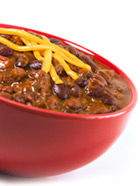 | Overcooking
- While it is nearly impossible to burn food while slow cooking, it is
possible to overcook the food and have it become undesirable. Follow
reliable recipes and suggested times. Slow-cooked dishes that are more
forgiving and can patiently wait for you include soups, stews, beans,
and larger cuts of meat. Grains, many vegetables, and desserts require
timing that is more precise.
Storing Slow-Cooked Dishes
- Once served, transfer any leftovers to a storage container, allow to
cool, then refrigerate - all within 2 hours of completed cooking. (The
heat-retaining properties of the crock make it unsuitable for cooling
foods quickly enough). Slow cookers work too slowly to be useful in
reheating foods. However, warmed foods can be kept warm in a pre-heated
slow cooker. Pay attention to safe food practices regarding timing and
temperatures. |
|
Slow Cookers 101
| 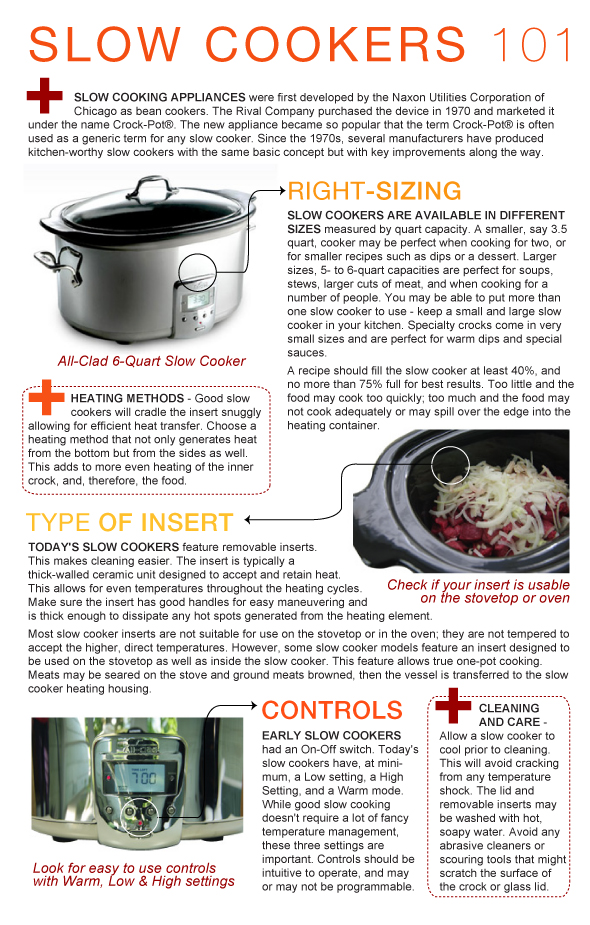
|
Smart Slow Cooking Tips
| Tip #1: Put your slow cooker(s)
to work at holiday gatherings where oven space and stovetop space is at
premium. Plug in one or two slow cookers and assign them to key recipes.
They'll accomplish the task on the side, away from most of the kitchen
flurry.

Tip #2: A tip from our featured author: layer the ingredients in the slow
cooker as called for in the recipe. Ingredients on the bottom will
receive more heat, and ingredients on top may be useful in basting
ingredients below. A classic example of this is a pot roast with root
vegetables. The vegetables actually take longer to cook than the meat
and benefit from the meat juices.
Tip #3: Take care when doubling recipes for the slow cooker. The different
quantities will change the cooking times. In any case, do not fill the
slow cooker more than three-quarters full.
Tip #4: Brown a couple of pounds of ground meat at a time and freeze the extra
pound in a freezer-grade zipper bag. The next time you slow cook a
recipe calling for the meat, the browning step is done.
Tip #5: Never immerse the outside heating unit in water. Simply wipe up any spilled food with a paper towel or dishtowel.
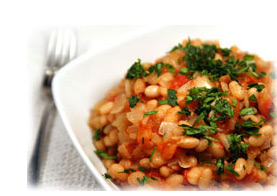 Tip #6: Most slow cooking is accomplished unattended. Liquids are condensed on
the lid and returned to the food. It's ok to lift the lid and stir once
or twice, but know that heat and steam are escaping with each peek. Tip #6: Most slow cooking is accomplished unattended. Liquids are condensed on
the lid and returned to the food. It's ok to lift the lid and stir once
or twice, but know that heat and steam are escaping with each peek.
Tip #7: Don't forget to taste
and adjust the seasonings in your slow cooked recipe. Spices and herbs
may lose their punch over the long cooking period. When cooking beans in
the slow cooker, salt only at the end. Salt toughens the skins of many
beans preventing them from becoming tender.
Tip #8: Place only thawed foods in a slow cooker. Frozen foods will suppress
the slow cooker's temperatures stalling the cooking, and perhaps making
the environment conducive to bacterial growth. Also, many inserts are
not tempered to withstand a collision of hot and cold.
|
Q & A's
| 
Q: What is sous vide?
A: An older technique currently experiencing a revival, sous videis another slow, low temperature cooking method. Food is placed in
airtight or vacuum-sealed plastic bags and placed in a water bath
appliance whose temperature is kept constant at a very low heat, around
140-160°F. The result is food that is quite tender and moist.
Q: How much liquid should I add? The recipes don't seem to call for enough liquid.
A: It's not unusual to think at the onset of a slow cooking recipe that
there is not enough liquid. But, slow cooking conserves moisture because
there is no evaporation or steam released. As food heats, it releases
its water; this quickly adds to the total amount of liquid. Use enough
liquid to cover, just barely, the ingredients. For best results, use a
reliable, tested recipe as a guide. 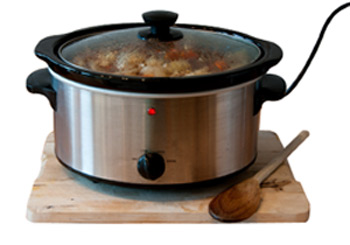
Q: A slow cooker is on for hours at a time, is it energy efficient?
A: Several factors go into determining the energy efficiency of slow
cooking. Newer models are definitely more energy efficient by design. A
slow cooker uses less energy than the stovetop or oven, but may operate
for longer periods. In actual use, a slow cooker is estimated to cost
about 2 cents an hour to operate. The one-pot nature of the slow cooker
increases the efficient use of energy.
Q: How can some of my favorite recipes be adapted to the slow cooker?
A: Many classics have been adapted for slow cooking methods. A good slow
cooker cookbook will have tested recipes available. If you're interested
in experimenting on your own, generally decrease the amount of liquid
used by about half, or just enough liquid to cover the food. (Rice and
pasta adaptations may be the exception here; maintain standard
water-to-grain ratios). Seasonings decrease in potency in long cooking;
add a bit more, or taste and adjust at the end of cooking.
|
Cookbook Review
| Slow & Easy, Fast -Fix Recipes for Your Electric Slow Cooker by Natalie Haughton. Published by John Wiley & Sons, Hoboken, NJ. Copyright 2009.
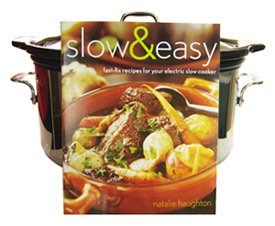 There
are many cookbooks for slow cooking on the market these days. We chose
to feature this one because it had an emphasis on the fast assembly of
ingredients. To really take everyday advantage of slow cooking, the
upfront preparation needs to be manageable in what are already very
hectic days. This book guides us in accomplishing our slow cooking
target of fast, easy, and then slow. It covers the classic slow cooker
world with one-pot meals, recipes for all kinds of meats, rich soups,
and stews. It also expands our slow cooking horizons by presenting dips,
drinks, salsas, pastas, grains, sides, ethnic flavors, and breakfast
fare. She concludes with slow cooker desserts such as cake, crème
brûlée, cheesecake, and crumbles. With this wide range of offerings, the
versatility of a slow cooker is repeatedly proven. True to its title,
recipes are assembled quickly and easily, then left for the slow cooker
to do the heavy lifting of coaxing and blending flavors. Your slow
cooker will have a permanent place on your countertop with this book
beside it. There
are many cookbooks for slow cooking on the market these days. We chose
to feature this one because it had an emphasis on the fast assembly of
ingredients. To really take everyday advantage of slow cooking, the
upfront preparation needs to be manageable in what are already very
hectic days. This book guides us in accomplishing our slow cooking
target of fast, easy, and then slow. It covers the classic slow cooker
world with one-pot meals, recipes for all kinds of meats, rich soups,
and stews. It also expands our slow cooking horizons by presenting dips,
drinks, salsas, pastas, grains, sides, ethnic flavors, and breakfast
fare. She concludes with slow cooker desserts such as cake, crème
brûlée, cheesecake, and crumbles. With this wide range of offerings, the
versatility of a slow cooker is repeatedly proven. True to its title,
recipes are assembled quickly and easily, then left for the slow cooker
to do the heavy lifting of coaxing and blending flavors. Your slow
cooker will have a permanent place on your countertop with this book
beside it.
|
Three Slow Cooker Recipes
| Black Bean Soup
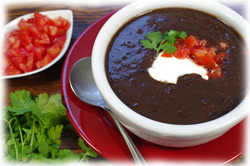 View & Print View & Print
With
ten minutes of effort in the morning, this hearty soup was ready for us
at suppertime. The slow cooker is great for cooking dried beans with no
tending of the flame, or chance for burning. The soup had deep, rich,
satisfying flavors. We topped our bowls with a dollop of sour cream and a
few dices of freshly chopped tomatoes. Hmmm, maybe a little shredded
cheese next time.
Barbecued Pulled Beef Sandwiches
 View & Print View & Print
This
recipe deliciously demonstrates another virtue of the slow cooker -
making inexpensive, tough cuts of meat succulent and tender. The aroma
that greeted us as we walked through the door that evening was
mouth-watering. The sandwiches were exactly what we thought a good
pulled beef sandwich should be. The leftovers were a pleasant redux.
Mediterranean Chicken with Artichokes,
Mushrooms, and Sun-Dried Tomatoes
 View and Print View and Print
The
slow cooker is not just for making everyday food, but is a huge boon
when entertaining. We served this recipe to company serving it over
pasta. The piquancy of the sun-dried tomatoes and the unique artichoke
flavor created a taste sensation that delighted our guests. This dish
may be cooked on high for 3 hours, or on low for 5 hours - choose what
fits your schedule.
Recipes from Slow & Easy by Natalie Haughton. Published by John Wiley & Sons, Hoboken, NJ.
Copyright 2009. Reprinted with permission of the publisher. All rights
reserved.
|
|
| Take five minutes in the morning to set up your slow cooker, save hours in the evening! |
|
|
|
|